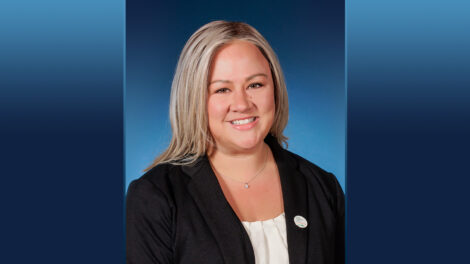America’s newest guardians…complex problem solvers
By Jill Spotz

Maj. Gen. David N. Miller Jr. ’93, director of operations at U.S. Space Command speaks to Professor Crain’s class.
Preparing for a final team presentation can be difficult. Project management, teamwork, conflict management, and coordination are just some of the skills flexed prior to presenting and defending the material. But what happens when the topic of your project is military satellites, and your presentation involves a major general of the United States Space Force in the room? Three Lafayette students, David Levchenko ’25, Reilly Hughes ’23, and Andrea Rivera Conte ’23, experienced this scenario at the end of the spring semester when they presented their final project, “National Defense and Security: Military Satellites,” in Prof. Mark Crain’s Industry, Strategy, and Policy class.
Throughout the semester, students in Crain’s class studied multifaceted problems in various sectors including financial services, energy and the environment, health care, and more. Students learned from experts in their fields including CEOs, board members, vice presidents, and more. Crain’s final class in May took to the skies as the topic involved national security and defense. Students were joined by Maj. Gen. David N. Miller Jr. ’93, director of operations at U.S. Space Command.
The Department of Defense experienced a rare change in organizational structure when it added a new military service in 2019, and along with it, a new combatant command focused on combining joint and combined military forces to protect and defend America’s interests in space. The last time a branch of the military was established was 75 years ago, when the Department of Defense created the U.S. Air Force in 1947.
The U.S. military has had an eye on the sky, or space that is, since the early 1900s. In 1915, the U.S. formed the National Advisory Committee for Aeronautics (NACA). This committee was the precursor to the National Aeronautics and Space Administration (NASA), which was formed in 1958. Now, the newest branch of the U.S. military, the U.S. Space Force, is unique in that it collaborates with NASA and private industries like Elon Musk’s SpaceX, making it the perfect topic for discussion in Crain’s class.

Andrea Rivera Conte ’23, Reilly Hughes ’23, and David Levchenko ’25 presented their final project, “National Defense and Security: Military Satellites,” in Prof. Mark Crain’s Industry, Strategy, and Policy class this spring.
Levchenko, Hughes, and Conte’s final project and presentation delved into the satellite sector within the U.S. military and defense industry, specifically the challenges and opportunities arising as the industry continues to evolve. The students hypothesized that the satellite sector will experience growth only if it continues to innovate and invest in new technologies, all while keeping an eye on policy implications.
The importance of innovation and investing in new technologies were also key conversation points as the class discussed how the U.S. Space Force is organized, operates, and is ensuring it is equipped for the future. The class learned how the U.S. Space Force is responsible for personnel, weapons, equipment, and expertise to accomplish military objectives, while the U.S. Space Command plans and directs the employment of joint military forces. The two are integral partners. And just as interdisciplinary learning incorporates multiple perspectives, the U.S. Space Command relies on the expertise of all branches of the military.
“Never before has the domain of operations covered an area of responsibility for space, which is now defined in policy by the President of the United States—starting at 100 kilometers and has no end. That is just where it starts,” Miller explained.
As the U.S. military plans for future contingencies, it trains its members to consider, at a minimum, six key factors to ensure a comprehensive and deliberate approach, an acronym known as PMESII—a strategic planning and decision-making model originally developed in the Army that incorporates a diverse set of inputs and perspectives, representing the Political, Military, Economic, Social, Infrastructure, and Information Systems elements bearing on a strategic challenge or problem. Holding true to the interdisciplinary focus of Crain’s class, the class discussed a wicked problem that requires a wide lens and broad input to solve.
In March 2022, SpaceX sent shipments of its Starlink satellite kits to Ukraine shortly after Russia invaded and the country’s internet capability was interrupted. The Starlink kits operate by connecting directly to Space X’s network in space. The class tried to answer the difficult question of whether the U.S. military has responsibility for defending SpaceX as a U.S. company.I found this class to be an enriching experience that gave me a unique insight into real-world sectors.
What I appreciated most was the opportunity to engage directly with experts in various fields, leading to a depth of understanding that no other class offered. It challenged me to think outside of the box and contemplate my future in ways I had not done before. As for Maj. Gen. Miller, his insights were invaluable. He is a remarkable individual whose knowledge extends beyond the military to include the Space Force, governmental functions, and decision-making processes at the highest levels. His participation in the class discussions deeply broadened my understanding of these areas.
~David Levchenko ’25
What the students learned is that the takeaway is not the answer to the question but how the U.S. government arrives at the best answer based on an interdisciplinary decision-making process. In this scenario, the implications and potential opportunities, challenges, and consequences of defending commercial companies involve economic, military, legal, and political considerations, among many. Perhaps the most significant takeaway for students was appreciation that the most substantial policy questions often require nuanced solutions with consideration of the last step in implementation before embarking on the first.
Hughes and Conte are now starting their next chapter after Lafayette. Hughes will be working in corporate and institutional banking in Jersey City, N.J. Conte landed a job as a paralegal at a law firm specializing in international trade in Washington, D.C. She plans to attend law school. Levchenko, a rising junior, will be working at a tech startup this summer and hopes to pursue a career in the biotech field.


